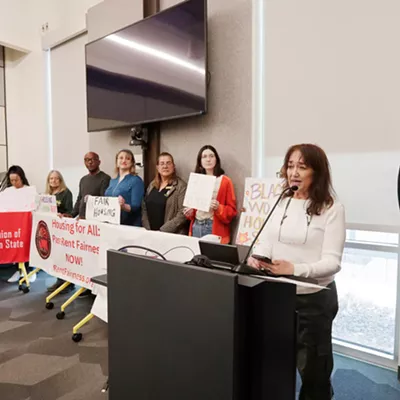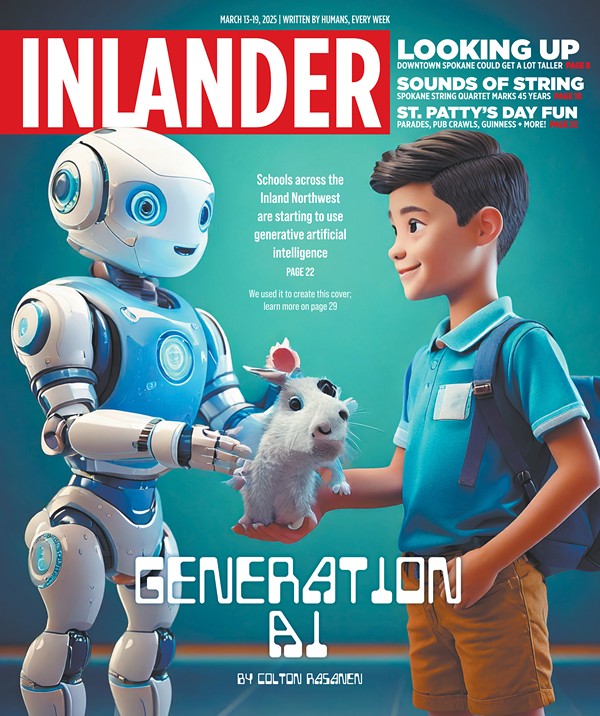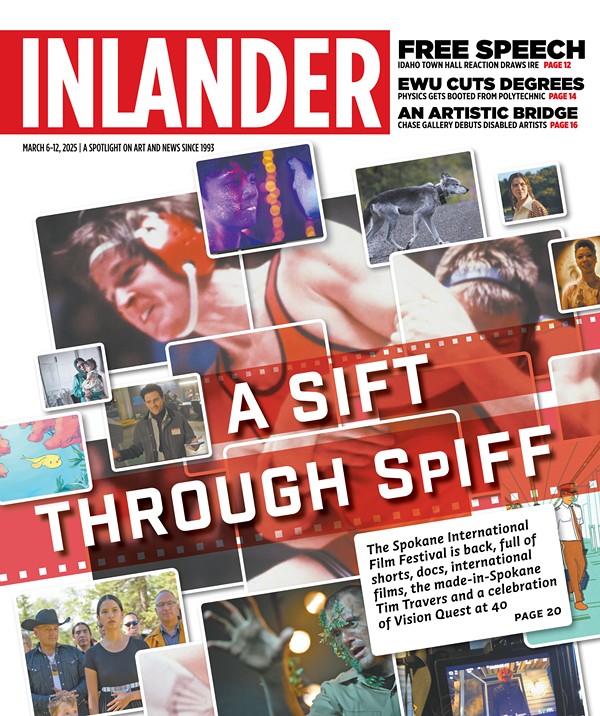Around the corner and up the entrance ramp from the Museum of Arts and Culture's exhibits about hometowns, a few gallery spaces away from details about regional rodeos and the "world's largest bovine hairball," rests a less familiar section of Spokane's city history. It's a small section of a wall, looking as though it has been removed from the side of a building, featuring a doorway and a window. Inside the window, against an unassuming background of spray-painted pegboard, sit some tattered religious images, texts and seemingly unrelated objects. On first glance, it could seem accidental -- its privileged status, alone at the end of a gallery, and the vinyl rope keeping visitors back from it are almost absurd.
But the case and the objects in it are not only a notable part of Spokane's cultural heritage; they're also the product of two of its most celebrated residents, artists Ed and Nancy Kienholz. The work -- a sculpture of theirs entitled The Jesus Corner, dating from 1982 and 1983 -- falls into the artists' most creative period, when they had already achieved international success and were working in their chosen mediums and ideas with an assured freedom. It was acquired by the museum in the 1990s and has rarely been exhibited since. After moving into the new space, however, says Museum Registrar Valerie Wahl, the museum decided it was time to have a small exhibit of the Kienholzes' works.
For Ed Kienholz, who grew up in Fairfield, Wash., and lived part of the year with his wife and collaborator Nancy in Hope, Idaho, as far back as 1973, regional identity was never far from the surface of his art. It's present in the construction skills he gained from growing up on a farm and in the sense of lost past that reflects a place like Spokane, a city enriched with history but suffering from recent declines.
Careful construction and a sense of loss fills the mature works of the Kienholzes, and helped gain them international acclaim in the arts world. They also generated a small degree of controversy between the beginning of Ed's career in L.A. until his death in 1994. A Playboy pinball machine, trimmed in a skirt of sculpted metal, confronts the gallery viewer with a naked pair of women's legs -- spread wide -- attached to the front of the machine. A nightmarish general rides a repressed person across a landscape of war built out of the pre-fabricated trappings of modern society. And a television is built from discarded building materials, with a family photograph in the place of a moving image: the highly personal simultaneously trapped within and lending grace to the impersonal. Their disturbingly familiar tableaux connect objects from different places and periods of time with thick coats of resin and paint, linking the past eras together and moving them -- modified -- into the viewer's present.
The most immediate sense of tension present in many of their works, however, is no familiar/unfamiliar but public/private. More than simply an accumulation of details, the objects found in many of the Kienholzes' pieces add up to a rich, inner life. From the used-up and discarded products of consumer culture, Ed and Nancy Kienholz fashioned portraits of the people who simultaneously gave rise to that culture and became trapped by it. But at the same time, the viewer bears witness to the scenario spelled out by the details of the sculptures, committing an act of voyeurism. In the way that a surreptitious peek into someone else's medicine cabinet gives a glimpse at the owner's private life, it is also a thrilling act of violation.
For their first work in what have been called the "Spokane pieces," which culminated in The Jesus Corner, the Kienholzes were simply searching for objects to evoke the inner life of a figure in their sculpture Sollie 17. "Ed always said that Sollie was his reaction to the old man he saw in a hotel once," Nancy Kienholz explains at her home in Hope. "He was passing down the hall and saw him sitting in his room. And he wanted to put that in a piece of art."
With Sollie 17, the viewer looks through a door, where three sculptures depict an old man living in a small, run-down hotel room. Surrounded by the barest trappings of life -- cans of food, a television, a dirty sink -- the man reads on his bed, plays solitaire on a chair, gazes out the window at the cityscape.
"We had to find all of the different things to go in this room," explains Nancy Kienholz. "So we went to Louie Ray, who owned several old buildings in Spokane, and told him we were building a piece that was in a hotel. He told us that he owned a hotel, and he gave us six keys to six different rooms, and told us that we could take anything we needed from them. The first room that we went in had a mattress on the bed with an enormous bloodstain in the middle of it. And I told Ed 'I can't do this,' so we closed the door, and went to another room, and started taking everything we could find: the sink, the bed frame, the wallpaper. We took almost everything from those rooms, including the doors. I still have some of the wallpaper -- I used some of it just last year."
While they were collecting the pieces of Sollie 17, the Kienholzes were staying at the Davenport Hotel and walking to the run-down Pericord Hotel. Each day they passed the corner of Bernard and Sprague, where a man named Roland Thurman had rented the storefront and filled the window with pictures, texts and religious objects. "Ed looked at that and said, 'There's a whole piece already right there,'" says Nancy Kienholz. "And right after we got back to our studio with everything we had collected from the hotel, we got a call from Louie telling us that we could come take anything we wanted from the building with 'The Jesus Corner.' He had advertised for the owner, and was ready to demolish the building."
Inside the building, the Kienholzes, along with their assistant Rich Post, found an overwhelming mass of objects collected by one man. "The whole thing was filled inside from floor to ceiling," recalls Kienholz. "Eventually, Roland Thurman had collected so much stuff that he couldn't live there any more. So we took pictures of everything, and then packed as much of it as we thought we could use -- including everything in the window -- and hauled it away."
Several years later, the Kienholzes partly recreated Thurman's window for The Jesus Corner. While the primary portion of the sculpture -- the window itself -- is recreated largely the way the Roland Thurman left it, the Kienholzes created other parts of the work. "You have to make up a fantasy," Nancy Kienholz says, explaining the process of creating a believable scenario like The Jesus Corner. "We talk about Sollie, from Sollie 17, like he's a real guy. And it has nothing to do with the person that you actually cast for the piece -- they're just a model. But usually you've created much of it already in your head, and you go out looking for things, and run into the rest. That's what's strange about all of the Spokane pieces that we built -- we built Sollie, and ran into all of those other pieces."
One of the most striking additions the Kienholzes brought to The Jesus Corner was the prominent position of a door to the right of the window. While there was a door at the original hotel, it was boarded up. In the Kienholzes' work, the door has a window, giving viewers an illicit glimpse into the inner detritus of a life contained behind the public front of personal religion. "I think about the man who built it -- Roland Thurman," Nancy Kienholz says. "I never met the man, but I think about the oddity of him -- how he was such an outsider. Obviously he had a certain religious opinion -- and in some ways it's very mundane and simple. But you look at so many churches, big and fancy, covered with gold, and I'm not sure they have any more God in them. His is more valid, because it is simple, and from the heart. It's the product of an individual, rather than an organization."
Adds the Kienholzes' longtime assistant Rich Post: "It was his way of expressing what he felt. And it was such a flip side of the incredible clutter that he lived in. But what he put in the window was what he felt, and he didn't have any problem expressing it."
Among the objects that Post and the Kienholzes collected from Thurman's living space was a hanging cabinet, to which Thurman had glued a picture of a woman. The Kienholzes' took the cabinet, and turned it into a small work of art, which is also on display, called Drawing for The Jesus Corner. Despite the word 'drawing' in the title, Nancy Kienholz explains that often she and her husband would craft the smaller works after the larger piece had been started. "The drawings come after or during the bigger pieces -- which is confusing, I know," she laughs. "It's more the leftover things that didn't get used. But also, because the bigger pieces can take so long to complete, it's nice to be able to complete something."
Nancy Kienholz herself isn't finished. She continues to produce art, spending part of the year in Berlin and part of the year in Hope. She's also a tireless advocate of other artists and along with Post, supervises the shipping and installation around the world of many of her and her husband's work.Around the corner and up the entrance ramp from the Museum of Arts and Culture's exhibits about hometowns, a few gallery spaces away from details about regional rodeos and the "world's largest bovine hairball," rests a less familiar section of Spokane's city history. It's a small section of a wall, looking as though it has been removed from the side of a building, featuring a doorway and a window. Inside the window, against an unassuming background of spray-painted pegboard, sit some tattered religious images, texts and seemingly unrelated objects. On first glance, it could seem accidental -- its privileged status, alone at the end of a gallery, and the vinyl rope keeping visitors back from it are almost absurd.
But the case and the objects in it are not only a notable part of Spokane's cultural heritage; they're also the product of two of its most celebrated residents, artists Ed and Nancy Kienholz. The work -- a sculpture of theirs entitled The Jesus Corner, dating from 1982 and 1983 -- falls into the artists' most creative period, when they had already achieved international success and were working in their chosen mediums and ideas with an assured freedom. It was acquired by the museum in the 1990s and has rarely been exhibited since. After moving into the new space, however, says Museum Registrar Valerie Wahl, the museum decided it was time to have a small exhibit of the Kienholzes' works.
For Ed Kienholz, who grew up in Fairfield, Wash., and lived part of the year with his wife and collaborator Nancy in Hope, Idaho, as far back as 1973, regional identity was never far from the surface of his art. It's present in the construction skills he gained from growing up on a farm and in the sense of lost past that reflects a place like Spokane, a city enriched with history but suffering from recent declines.
Careful construction and a sense of loss fills the mature works of the Kienholzes, and helped gain them international acclaim in the arts world. They also generated a small degree of controversy between the beginning of Ed's career in L.A. until his death in 1994. A Playboy pinball machine, trimmed in a skirt of sculpted metal, confronts the gallery viewer with a naked pair of women's legs -- spread wide -- attached to the front of the machine. A nightmarish general rides a repressed person across a landscape of war built out of the pre-fabricated trappings of modern society. And a television is built from discarded building materials, with a family photograph in the place of a moving image: the highly personal simultaneously trapped within and lending grace to the impersonal. Their disturbingly familiar tableaux connect objects from different places and periods of time with thick coats of resin and paint, linking the past eras together and moving them -- modified -- into the viewer's present.
The most immediate sense of tension present in many of their works, however, is no familiar/unfamiliar but public/private. More than simply an accumulation of details, the objects found in many of the Kienholzes' pieces add up to a rich, inner life. From the used-up and discarded products of consumer culture, Ed and Nancy Kienholz fashioned portraits of the people who simultaneously gave rise to that culture and became trapped by it. But at the same time, the viewer bears witness to the scenario spelled out by the details of the sculptures, committing an act of voyeurism. In the way that a surreptitious peek into someone else's medicine cabinet gives a glimpse at the owner's private life, it is also a thrilling act of violation.
For their first work in what have been called the "Spokane pieces," which culminated in The Jesus Corner, the Kienholzes were simply searching for objects to evoke the inner life of a figure in their sculpture Sollie 17. "Ed always said that Sollie was his reaction to the old man he saw in a hotel once," Nancy Kienholz explains at her home in Hope. "He was passing down the hall and saw him sitting in his room. And he wanted to put that in a piece of art."
With Sollie 17, the viewer looks through a door, where three sculptures depict an old man living in a small, run-down hotel room. Surrounded by the barest trappings of life -- cans of food, a television, a dirty sink -- the man reads on his bed, plays solitaire on a chair, gazes out the window at the cityscape.
"We had to find all of the different things to go in this room," explains Nancy Kienholz. "So we went to Louie Ray, who owned several old buildings in Spokane, and told him we were building a piece that was in a hotel. He told us that he owned a hotel, and he gave us six keys to six different rooms, and told us that we could take anything we needed from them. The first room that we went in had a mattress on the bed with an enormous bloodstain in the middle of it. And I told Ed 'I can't do this,' so we closed the door, and went to another room, and started taking everything we could find: the sink, the bed frame, the wallpaper. We took almost everything from those rooms, including the doors. I still have some of the wallpaper -- I used some of it just last year."
While they were collecting the pieces of Sollie 17, the Kienholzes were staying at the Davenport Hotel and walking to the run-down Pericord Hotel. Each day they passed the corner of Bernard and Sprague, where a man named Roland Thurman had rented the storefront and filled the window with pictures, texts and religious objects. "Ed looked at that and said, 'There's a whole piece already right there,'" says Nancy Kienholz. "And right after we got back to our studio with everything we had collected from the hotel, we got a call from Louie telling us that we could come take anything we wanted from the building with 'The Jesus Corner.' He had advertised for the owner, and was ready to demolish the building."
Inside the building, the Kienholzes, along with their assistant Rich Post, found an overwhelming mass of objects collected by one man. "The whole thing was filled inside from floor to ceiling," recalls Kienholz. "Eventually, Roland Thurman had collected so much stuff that he couldn't live there any more. So we took pictures of everything, and then packed as much of it as we thought we could use -- including everything in the window -- and hauled it away."
Several years later, the Kienholzes partly recreated Thurman's window for The Jesus Corner. While the primary portion of the sculpture -- the window itself -- is recreated largely the way the Roland Thurman left it, the Kienholzes created other parts of the work. "You have to make up a fantasy," Nancy Kienholz says, explaining the process of creating a believable scenario like The Jesus Corner. "We talk about Sollie, from Sollie 17, like he's a real guy. And it has nothing to do with the person that you actually cast for the piece -- they're just a model. But usually you've created much of it already in your head, and you go out looking for things, and run into the rest. That's what's strange about all of the Spokane pieces that we built -- we built Sollie, and ran into all of those other pieces."
One of the most striking additions the Kienholzes brought to The Jesus Corner was the prominent position of a door to the right of the window. While there was a door at the original hotel, it was boarded up. In the Kienholzes' work, the door has a window, giving viewers an illicit glimpse into the inner detritus of a life contained behind the public front of personal religion. "I think about the man who built it -- Roland Thurman," Nancy Kienholz says. "I never met the man, but I think about the oddity of him -- how he was such an outsider. Obviously he had a certain religious opinion -- and in some ways it's very mundane and simple. But you look at so many churches, big and fancy, covered with gold, and I'm not sure they have any more God in them. His is more valid, because it is simple, and from the heart. It's the product of an individual, rather than an organization."
Adds the Kienholzes' longtime assistant Rich Post: "It was his way of expressing what he felt. And it was such a flip side of the incredible clutter that he lived in. But what he put in the window was what he felt, and he didn't have any problem expressing it."
Among the objects that Post and the Kienholzes collected from Thurman's living space was a hanging cabinet, to which Thurman had glued a picture of a woman. The Kienholzes' took the cabinet, and turned it into a small work of art, which is also on display, called Drawing for The Jesus Corner. Despite the word 'drawing' in the title, Nancy Kienholz explains that often she and her husband would craft the smaller works after the larger piece had been started. "The drawings come after or during the bigger pieces -- which is confusing, I know," she laughs. "It's more the leftover things that didn't get used. But also, because the bigger pieces can take so long to complete, it's nice to be able to complete something."
Nancy Kienholz herself isn't finished. She continues to produce art, spending part of the year in Berlin and part of the year in Hope. She's also a tireless advocate of other artists and along with Post, supervises the shipping and installation around the world of many of her and her husband's work.
















